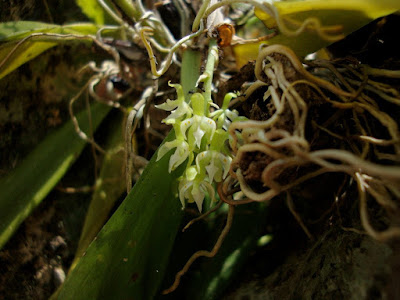Notylia barkeri is widespread from Mexico through Central America to Panama, and in northern South America, it is even found in Amazonas, Pará and Pernambuco in Brazil, where its occurrence is limited to warm, moist lowlands...
Notylia barkeri also called as Barker's Notylia, Notylia albida, Notylia bernoullii, Notylia bipartita, Notylia brenesii, Notylia guatemalensis, Notylia multiflora, Notylia tamaulipensis, is a species of the genus Notylia. This species was described by John Lindley in 1838.
IDENTIFY NOTYLIA BARKERIA
Notylia barkeri is widespread from Mexico through Central America to Panama, and in northern South America, it is even found in Amazonas, Pará and Pernambuco in Brazil, where its occurrence is limited to warm, moist lowlands. In Mexico, this orchid is found in trees in shady ravines and valleys along streams, in forests on trees with leaves falling for winter, in the lowlands along the Pacific coast, at altitudes from sea level up to 900 m. There are reports of this orchid in the state Jalisco near Puerto Vallarta and in the states of Michoacan, Guerrero, Oaxaca, Veracruz, San Luis Potosi and Yucatan. In Belize, it is found in all districts. It is found on trees and bushes on citrus plantations and in various types of forests and thickets at altitudes up to 400 m. It often grows in well-shaded places where other orchids are also found. In Guatemala, it is found in the departments of Alta Verapaz, Escuintla, Izabal, Petén and Santa Rosa, where it usually grows epiphytically on trees and shrubs in dense, damp forests, swamps and on coffee tree plantations. Usually, these are low altitudes, but were encountered even at an altitude of 1600 m. In Honduras is found in the Caribbean basin near Comayagua, at an altitude of 200-220 m. In Nicaragua is found in the departments of Jinotega, Matagalpa and Rivas and in numerous places in Zelaya from sea level up to 900 m. In Costa Rica it is found in the provinces of Alajuela and Puntarenas at heights of 40-1000 m.
It is a nice epiphytic, hot to cool growing, miniature sized plant, which reaching up to 20 cm in size, with clustered, ellipsoid, compressed, 3.5 cm long and 1.3 cm wide pseudobulbs that are basally enveloped by non-foliaceous, scarious sheaths and carrying a single, apical, coriaceous, erect or spreading, oblong-ligulate to broadly elliptic, obliquely tridentate at the rounded or subacute apically, 20 cm long and 5.5 cm wide leaf.
Barker's Notylia blooms in the spring on an axillary, pendulous, racemose or rarely paniculate, to 30 cm long, laxly many flowered inflorescence with scarious bracts carrying slightly fragrant flowers. The flowers are 0.8 cm in diameter. These flowers have light green petals of the outer whorl, white petals of inner whorl with a few yellow spots at the base, a white lip and a light green rod. Small flowers have a slightly bucket shape, and the petals of both whorls at the base curve forward. Almost all of their vertices are directed forward, apart from the tops of the side outer petals, which may be curved backwards, sometimes even quite sharply.
NOTYLIA BARKERIA CARE AND CULTURE
Cultural information should only be used as a guide, and should be to be adapted to suit you. Your physical location; where you grow your plants, how much time you have to devote to their care, and many other factors, will need to be taken into account. Only then can you decide on the cultural methods that best suit you and your plants.
Light:
Notylia barkeri needs a light level of 15000-23000 lux. The light should be filtered or dispersed, and the plant should not be exposed to the direct sunlight of the midday sun. Strong air movement should be ensured all the time.
Temperature:
The average temperature of the summer day is 29 ° C, night 22 ° C, and the daily difference is 7 ° C. The average temperature of the winter day is 25-26 ° C, the night 17-19 ° C, and the daily difference is 7-8 ° C.
Humidity:
Barker's Notylia needs the humidity of almost 80% throughout the year.
Substrate, growing media and repotting:
It is best to grow Notylia barkeri mounted on tree-fern rootstocks or cork.
Watering:
In the natural habitat, rainfall is abundant to very abundant for most of the year, but at the end of winter and early spring it is a bit drier. The cultivated plants should be abundantly watered during active growth, but excellent drainage must be ensured.
Fertilizer:
Weekly use of 1/4-1/2 of the recommended dose of orchid fertilizer is recommended.
Rest period:
At the end of winter and early spring the rainfall is much lower, Notylia barkeri need to reduce the amount of water, but they can not stay without water for too long.















COMMENTS